Book contents
- Frontmatter
- Contents
- Foreword
- On Christian de Duve: An Editor's Appreciation
- General Introduction
- 1 Building Blocks
- 2 Homochirality
- 3 Protometabolism
- 4 ATP
- 5 Electrons and Protons
- 6 Thioesters
- 7 RNA
- 8 Proteins
- 9 DNA
- 10 Membranes
- 11 Protonmotive Force
- 12 Protometabolism Revisited
- 13 The LUCA
- 14 The First Fork
- 15 Eukaryotes
- 16 Oxygen
- 17 Endosymbionts
- 18 Multicellulars
- 19 Homo
- 20 Evolution
- Final Comments
- Bibliography
- Index
7 - RNA
Published online by Cambridge University Press: 18 January 2010
- Frontmatter
- Contents
- Foreword
- On Christian de Duve: An Editor's Appreciation
- General Introduction
- 1 Building Blocks
- 2 Homochirality
- 3 Protometabolism
- 4 ATP
- 5 Electrons and Protons
- 6 Thioesters
- 7 RNA
- 8 Proteins
- 9 DNA
- 10 Membranes
- 11 Protonmotive Force
- 12 Protometabolism Revisited
- 13 The LUCA
- 14 The First Fork
- 15 Eukaryotes
- 16 Oxygen
- 17 Endosymbionts
- 18 Multicellulars
- 19 Homo
- 20 Evolution
- Final Comments
- Bibliography
- Index
Summary
It is generally accepted that RNA came before DNA in the origin of life. What we know of present-day life gives strong support to that contention. In all living organisms, DNA's sole function is to serve as the replicable repository of genetic instructions. When it comes to the execution of these instructions, RNA is the indispensable intermediary, occasionally as catalyst (ribozyme), most often as messenger (mRNA) for the synthesis of a protein that operates as the actual agent. DNA, in other words, can do nothing without RNA. In fact, DNA cannot even replicate without the prior formation of an RNA primer. RNA, on the other hand, while being the obligatory instrument of all forms of genetic expression, does, in addition, share with DNA the property of replicability. This property is not manifested in normal cells but is realized in cells infected by certain viruses, such as the polio virus. Thus, we arrive at the almost inevitable conclusion that RNA was first on the scene, acting in the storage and replication of early genetic information as well as in its expression, until DNA appeared and took over the first functions.
There are solid reasons to believe that RNA preceded proteins as well. This claim, again, rests on our knowledge of present-day life, which universally depends on RNA molecules – tRNAs, mRNAs, and rRNAs – for the synthesis of proteins.
- Type
- Chapter
- Information
- SingularitiesLandmarks on the Pathways of Life, pp. 66 - 87Publisher: Cambridge University PressPrint publication year: 2005

